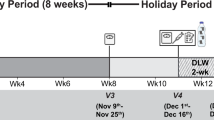Abstract
This report examines several issues concerning the effects of dietary fats and carbohydrates (CHOs) on body weight and the limits set on the intake of these nutrients by factors influencing appetite control: (i) the physiological relationship between feeding behaviour (FB) and body weight; (ii) the distribution of nutrients in Western foods and the implications this may have for FB; (iii) the contribution of nutrients in the diet, to total EI under both extreme and typical Western conditions; (iv) the known effects that fats, CHOs and dietary energy density (ED) exert on appetite and energy balance (EB); (v) the potential role of sensory factors in promoting or limiting fat, CHO and energy intakes (EI) in modern human populations
Population studies and large surveys have identified individuals with wide ranges of fat and CHO intakes. Intakes of fat can vary from an average of 180 g/day to 25 g/day in a representative sample. But on individual days fat intake can rise to well over 200 g according to a selection of high fat foods. In a single meal, people can consume an amount of fat greater than the population daily average. From this analysis it can be deduced that the appetite control mechanism will permit the consumption of large amounts of fat (if an abundance of high fat foods exist in the food supply). Except for specific physiological circumstances (e.g. endurance explorers) where there is an urgent need for EIs, in the face of decreasing body weight, it is unlikely that the body will generate a specific drive for fat. Because CHO foods have a lower ED than fat foods (on average) and because of their greater satiating capacity, the free intake of high CHO foods is likely to be self-limiting (at lower EIs than those generated by fatty foods). This does not mean that excess EIs are impossible when people feed ad libitum on high CHO diets.
This is a preview of subscription content, access via your institution
Access options
Subscribe to this journal
Receive 12 print issues and online access
$259.00 per year
only $21.58 per issue
Buy this article
- Purchase on Springer Link
- Instant access to full article PDF
Prices may be subject to local taxes which are calculated during checkout
Similar content being viewed by others
Author information
Authors and Affiliations
Rights and permissions
About this article
Cite this article
Blundell, J., Stubbs, R. High and low carbohydrate and fat intakes: limits imposed by appetite and palatability and their implications for energy balance. Eur J Clin Nutr 53 (Suppl 1), s148–s165 (1999). https://doi.org/10.1038/sj.ejcn.1600756
Published:
Issue Date:
DOI: https://doi.org/10.1038/sj.ejcn.1600756
This article is cited by
-
Obesity-induced taste dysfunction, and its implications for dietary intake
International Journal of Obesity (2021)
-
Meeting the nutritional needs of elderly residents in aged-care: Are we doing enough?
The Journal of nutrition, health and aging (2013)
-
Consuming two additional serves of dairy food a day significantly improves energy and nutrient intakes in ambulatory aged care residents: A feasibility study
The Journal of nutrition, health and aging (2013)
-
Physiological aspects of energy metabolism and gastrointestinal effects of carbohydrates
European Journal of Clinical Nutrition (2007)
-
Übergewicht und Adipositas im Kindes- und Jugendalter
Monatsschrift Kinderheilkunde (2007)



